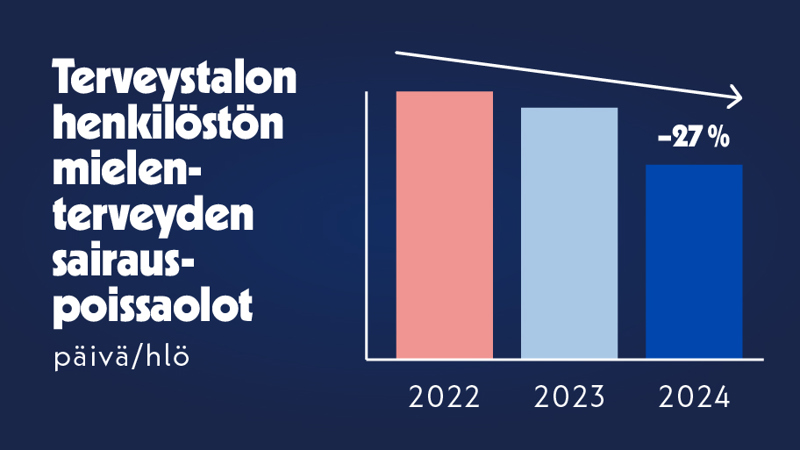Are you the dynamo in your team?
According to Antti Aro, Terveystalo's Chief Occupational Health Psychologist, the best way to ensure the well-being and success of the entire team is a leader who knows three things.

The team remains happy and healthy if the manager has adopted the three golden rules of a serving leader:
- Have courage
- Create safety
- Listen
The first rule, courage, is actually the most important. What we are talking about here is not showing off or being reckless; we’re talking about humble, inner courage. It’s important to make the distinction between bravery and courage. A serving leader implements the latter.
A courageous leader puts themselves out there. If necessary, they act like a bulldozer that clears space for others. They believe in their vision and they won’t let others bring them down. They get the team on board because they inspire a great deal of motivation in the entire group. This kind of leader is believed and followed.
A courageous leader is not a puppet or a follower. They do not work to simply make their own supervisor happy. Instead, they think about the goals of their organization and the best interests of their customers.
Of course, behind this courageous action lies a clear analysis that the goal is the right one. If the leader makes a mistake, they’re willing to admit it. After all, they are an emotionally mature adult.
Safety without indulgence
Creating safety is necessary to allow the team to focus on their core task. Psychological safety proved to be the most important success factor, for example, for Google's “perfect team”.
What does safety mean? It does not mean helicopter parenting or being a pushover; in fact, excessive softness on the part of the leader can create a feeling of insecurity. The employees may feel that the leader has lost control.
In a safe atmosphere, all team members know what they're doing and why. The leader is predictable and consistent and does not behave unpredictably.
The most important quality of a safe leader is being fair and just. Equal treatment creates well-being in the team, while the opposite behavior – unfair and unpredictable – has been shown to increase cardiac diseases and sleep disorders, among other things.
Once the team feels comfortable and able to work in peace, each member of the team will have the courage to be open and to be themselves. Everyone can trust that the members of the team support each other, and people also have the courage to talk about problems. Open sharing of information is also essential; when team members have access to all the information they need, they have the best possible prerequisites for action.
Sharing information is particularly important in difficult times. When, for example, cooperation negotiations are taking place in the organization, the atmosphere of trust is being tested. The leader must be present and available and share any information they can provide. One important task of a serving leader is to help people move forward in their lives and careers – even when the roads lead in different directions.
Listening is learning
Listening sounds like a simple task, but it is not always the case. First of all, a leader really needs to focus on listening. If you distract yourself, you don't really hear what the other person is trying to say. It is also important to show that you are listening. This basic rule of communication is not always realized in everyday work situations. Look the person in the eye, nod, ask questions.
You don't have to be able to answer everything right away. In fact, patience is very important, because it is good for a leader to learn to control their impulsiveness. Nor should the leader dismiss any issues the employees want to talk about. Particularly in complex matters, we recommend returning to the topic after considering it thoroughly.
You must listen to everyone equally. Having cliques causes problems in any work community. Make sure that you also listen and hear those who are more unlikely to come talk to you. You might get the best ideas and the most important information from them.
Lue lisää aiheesta

Terveystalo and MIELI Mental Health Finland are jointly promoting mental well-being
Terveystalo and MIELI Mental Health Finland have agreed on a long-term partnership aimed at strengthening the mental health and well-being of Finns and finding solutions to the mental health crisis.

Occupational health psychologists are underutilized amidst the tsunami of mental health issues
The increase in psychological problems and burnout at work is constantly being discussed. Mental health disorders are one of the major causes of decreased work efficiency, absenteeism, and transition to disability pensions. One might ask why this situation persists, despite the fact that our country has a unique and highly regarded occupational health care system, with a large number of experts in the connection between work and mental health – us occupational health psychologists.

Collaboration is the only way to solve wicked problems
Disability due to mental health challenges is a complex and nebulous problem that cannot be solved by individual tricks. It requires a long-term and systematic approach at both individual and community level. According to Simo Taimela, senior epidemiologist at Terveystalo, tackling the mental health epidemic requires both preventive measures for work communities and targeted and effective treatment for those who will benefit most.

Mental health-related sickness absences finally started to decrease - Terveystalo commits to an ambitious target for 2025
In Finland, it is estimated that up to 7 million working days are lost each year due to mental health-related sick leave. Not only can mental health challenges, if chronic, lead to unnecessary premature exclusion from working life, but the situation is also unsustainable for Finland's vitality and national economy. Recent data from Terveystalo show that timely and appropriate interventions have reduced the duration of mental health-related absenteeism and brought it down for the first time in a decade. This significant turnaround gives hope that the mental health crisis can be prevented, but it will require a concerted effort by all concerned.

Terveystalo increases transparency in the mental health debate and will in future publish information on the company's own mental health-related sickness absences
By publishing Terveystalo's own mental health absence statistics, Terveystalo wants to increase transparency in the mental health debate and encourage organisations to share their own successes in tackling the mental health crisis.

How to prevent overheating in working life - A recent survey shows that 80% of Finns feel the pace of working life has accelerated
According to a survey* commissioned by Terveystalo, up to four out of five Finns feel that the pace of working life has become faster and more stressful. Only 13% of respondents feel that working life is developing in a positive direction. This acceleration of the pace of work is reflected in a growing number of mental health problems among working-age people, which affects their ability to work and the productivity and growth prospects of companies. Terveystalo's organisational psychologists Jaakko Sahimaa and Annamari Heikkilä call for a sustainable pace of work as a solution to the overheating of working life.